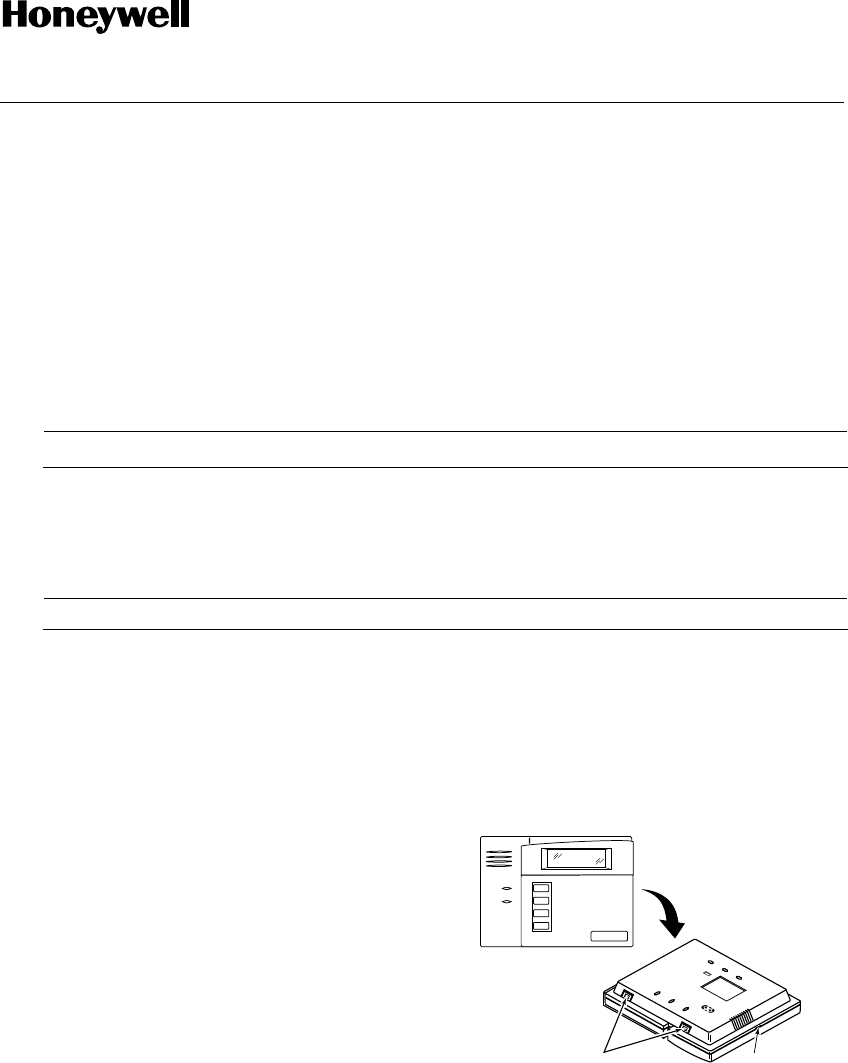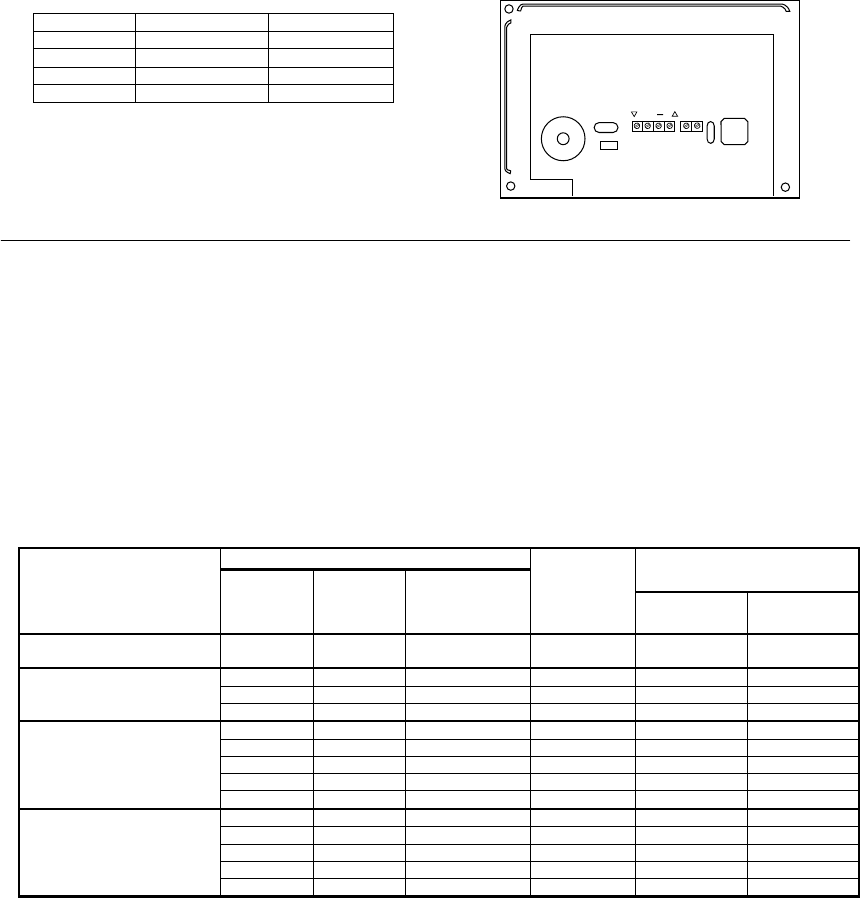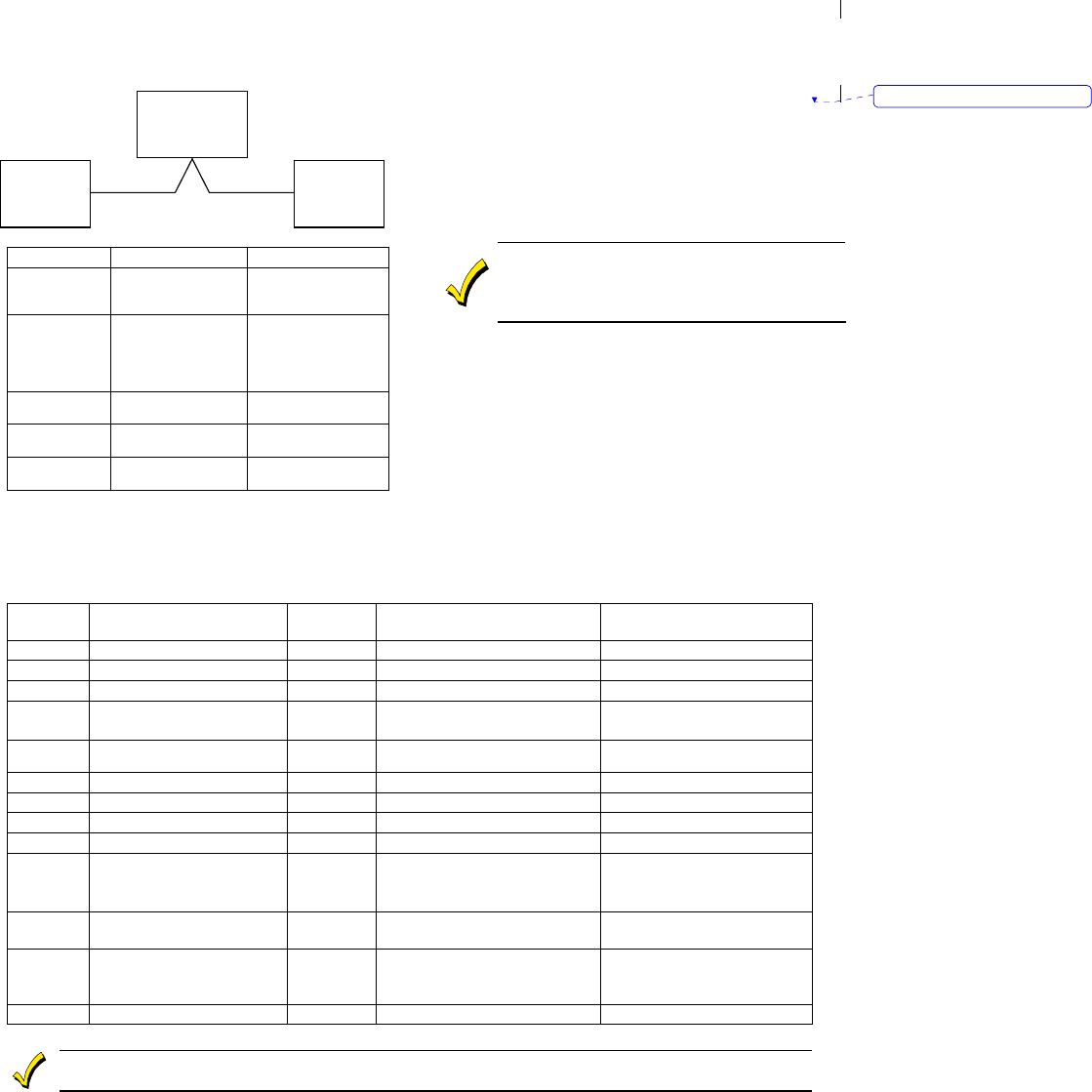Ademco 8DL6150RFT2 Keypad Transceiver User Manual
Honeywell International Inc. Keypad Transceiver Users Manual
Ademco >
Users Manual

K4460-1V6 2/06 Rev C
ADEMCO 6150RF
ADEMCO 6150RFADEMCO 6150RF
ADEMCO 6150RF
Keypad/Transceiver
Keypad/TransceiverKeypad/Transceiver
Keypad/Transceiver
INSTALLATION AND SETUP GUIDE
GENERAL INFORMATION
The 6150RF Keypad/Transceiver is a combination unit incorporating a normally-open relay output and the functions of:
• 6150 Fixed Addressable Keypad
• 5881M RF Receiver
• 5800TM Transmitter Module
The 6150RF Keypad/Transceiver may be used on any control panel that supports the 6150 Keypad.
Wireless Features
The 6150RF supports the following:
• 5828/5828V wireless keypads.
• Up to eight wireless keys locally (programmed directly into
6150RF) without occupying any zones supported by the control
panel.
• Button-type transmitters (e.g., 5804, 5804BD) for local operation.
• A maximum of 16 transmitters programmed into any 5800
Series-supported control panel.
• Wireless keys with high-security (e.g., 5804E).
• RF jam detection when the receiver is enabled.
• Low-battery indications for the local wireless keys.
• A nominal range of 200' for the RF transmitters (some
transmitters have a shorter range).
• Wireless keys for control panels that do not support RF
themselves (such as 4110DL).
• Sends status signals (Armed, Ready, etc.) to bi-directional
units such as 5804BDV and 5828/5828V.
U
UU
UL
LL
L The 5802, 5802MN, 5802MN2, 5804, 5804BD, 5804BDV, 5804E, 5814, 5816TEMP, 5819, 5819BRS, 5819WHS, 5828/5828V and 5850
transmitters are not intended for UL installations.
Programming Features
• Auto Enroll mode for programming wireless keys.
• Provides a method for deleting a serial number and re-enrolling a new one in its place.
• Provides default settings for the wireless key functions.
Additional Features
• Operates the on-board relay in conjunction with the receiver (e.g., to trip a garage door opener).
U
UU
UL
LL
L This feature is not intended for UL installations.
• Activates relays programmed into the control panel.
• Provides an End User mode to enable/disable local wireless keys (e.g., if a user accidentally loses a wireless key). Refer to the
6150RF User Guide for this procedure.
INSTALLING THE 6150RF
Locate the 6150RF in an area and at a height where it is
convenient for user operation. The 6150RF must be at least
10 feet from the control panel to ensure proper operation of
the RF receiver. Perform the following steps to install the
6150RF.
1. Push the two case release snaps at the bottom of the
keypad with the blade of a medium screwdriver (this will
push in the release snap), then pull that side of the case
back away. Insert the screwdriver in the side of the
keypad (between the front and back case) and gently
twist to release the side locking tab. Repeat for the other
side. Refer to Figure 1 for location of the case back
release snaps and locking tabs.
2. Route the wiring from the control panel through the
opening in the case back. (See the control panel’s
instructions for proper wire run lengths.)
3. Mount the case back directly to a wall or electrical gang
box.
4. Connect the power and data wires from the control panel
to the terminals on the 6150RF as indicated in the
wiring table adjacent to Figure 2.
5. Connect the wires for the relay output (if used) to the
terminals on the 6150RF’s PC board.
6. Reattach the keypad to its case back.
Note: Upon power-up or exit of the Program Mode, the 6150RF
alternately flashes "Ad" and the 2-digit keypad address and
the 2-digit receiver address on the display. Press any key to
display the system status.
NOTE:
TO REMOVE CASE BACK
PUSH IN THE TWO MOUNTING
SNAPS LOCATED ALONG THE
BOTTOM OF THE KEYPAD
AND LIFT UP.
6150-006-V0
RETAINING
SNAPS
ARMED
READY
LOCKING
TAB
Figure 1 – Removing the 6150RF Case Back
PLEASE GO TO PAGE 8 FOR THE
FCC AND IC STATEMENTS.

- 2 -
WIRING TABLE
Keypad Control Panel Wire Color
▲G Data In Green
− − Aux Pwr (GND) Black
+ + Aux Pwr Red
▼Y Data Out Yellow
Note: NO (normally Open) and C (common) are the
connections for the relay output
+
6150RF-003-V2
NO C
YG
Figure 2 - 6150RF Wiring Connections
APPLICATION GUIDELINES
Use the following guidelines when planning an installation:
• Local wireless keys (wireless keys programmed directly into the 6150RF) may be used regardless of whether the
RF receiver in the 6150RF is enabled or disabled.
• If using bi-directional devices, be sure to enable the transmitter module in the 6150RF.
• If transmitters are programmed into the control panel, be sure to enable the receiver. (Make sure you do not
exceed the number of receivers supported by the control panel.)
• If a local wireless key is programmed to arm/disarm or to trigger a relay on the control panel, a user code must be
entered into the 6150RF. This user code must also be programmed into the control panel.
• You must set the House ID only if you are using RF keypads and/or bi-directional devices; AND the House ID
Source is the 6150RF (Local).
6150RF Application Guide
The following guide outlines how to program the wireless keys, RF receiver, and the House ID in the 6150RF for your
installation.
* Two 6150RFs are needed for this application: one assigned to partition 1 and one assigned to partition 2.
** If using an RF keypad on only one partition, the 6150RF’s partition assignment in panel programming must match the partition.
*** If set for Local on a partition control, the 6150RF’s partition assignment must match the one programmed in the BD device.
Are you using 6150RF Programming Options
System Control Panel RF keys
beyond
system’s
capacity?
RF receivers
beyond
system’s
capacity?
RF keypads and/or
Bi-directional
devices on more
than 1 partition?
Program
Wireless Keys
Into Receiver
Enable House ID
Source***
4110DL, 4110XM, 4140XMP,
VISTA-20HWSE N/A N/A N/A 6150RF OFF Local [0]
NO NO N/A System ON [1] System [1]
YES NO N/A 6150RF ON [1] System [1]
VISTA-10P, VISTA-10SE, VISTA-
15, VISTA-15P, VIA-30PSE
YES YES N/A 6150RF OFF [0] Local [0]
NO NO NO System ON [1] System [1]
YES NO NO 6150RF ON [1] System [1]
YES YES NO 6150RF OFF [0] Local [0]
NO YES YES* System OFF [0] Local [0]
VISTA-20SE, VISTA-20P
YES YES YES* 6150RF OFF [0] Local [0]
NO NO NO** System ON [1] System [1]
YES NO NO** 6150RF ON [1] System [1]
YES YES NO** 6150RF OFF [0] Local [0]
NO YES YES System OFF [0] Local [0]
VISTA-40, VISTA-50P, VISTA-
128B, VISTA-128BP
YES YES YES 6150RF OFF [0] Local [0]

- 3 -
An example of an installation using two 6150RF
Keypad/Transceivers with 2-Way Wireless Devices (e.g.,
5828V) on Two Partitions is shown below:
Settings 6150RF #1 6150RF #2
Keypad: Must be assigned to
Partition 1 in the
control panel
Must be assigned to
Partition 2 in the
control panel
House ID: Match Partition 1
House ID in the
control panel and
House ID in Wireless
Device
Match House ID in
Wireless Device
House ID
Source: System Local
Receiver
Enable: On Off
Transmitter
Enable: On On
PROGRAMMING THE 6150RF
The 6150RF is shipped with pre-programmed default
values. Later in these instructions are diagrams showing
the wireless keys' loops and their default functions.
Regardless of which wireless key you use (even if it is one
not shown), loops 1-4 are defaulted for all eight devices as
shown. These values may be changed to suit the
installation.
Entering Program Mode
Press the [1] and [3] keys simultaneously for a few seconds
within 30 seconds after applying power. The keypad beeps
three (3) times, and two dashes and two zeroes flash
alternately in the upper left-hand corner of the display. If
any other numbers or letters flash in the display, press the
[✻] key.
Note: The keypad will not enter programming mode if the system
has been armed before the 6150RF was powered up or
down.
Pressing the [1] and [3] keys 30 seconds or more after
applying power allows you to enter the User mode. This mode
allows you to enable and disable individual local wireless keys
(useful if, e.g., a user accidentally loses a wireless key). Refer
to the User Guide for instructions.
Programming Operations
Once you have entered the Program mode, you may move to
any program address simply by entering the program
address number. The 6150RF will automatically exit the
Program mode if no keys are pressed for 90 seconds. While
in the Program mode:
• Pressing the [✻] key stores the information displayed,
then moves you to the next prompt, and the keypad beeps
twice.
• Pressing the [#] key erases the current information and
moves you back so you may enter the correct information.
Enter a program address (e.g., press [1] for Keypad
Address; [2] for Receiver Address) to set the parameters in
the 6150RF.The following chart lists the program addresses,
the keypad display, and the choices.
Program
Address Description Display Choices Default
1 Keypad Address cA 01-31 31
2 Receiver Address rA 00-30 00
3 House ID HI 01-31 10
4 House ID Source hS 1 = System
0 = Local
1 System
5 Wireless Key Editing d- Enter Existing Device Number
6 Receiver Enable rE 1 = On 0 = Off 1 Enable
7 Transmitter Module Enable tE 1 = On 0 = Off 1 Enable
8 Wireless Key Auto Enroll d* Enter Serial Number
8 then 2 Wireless Key User Code u4 Enter 4-Digit User Code
8 then 4 Wireless Key Loop Function Ln Enter Loop Number then Function
(See Wireless Key Function Chart) Loop 2 1 (Disarm)
Loop 3 2 (Arm Away)
Loop 4 3 (Arm Stay)
8 then 5 Wireless Key On-Board Relay
Assignment o- Enter Loop Number then Relay
Action Loop 1 Close for 2 Seconds
9 Restore Defaults EE 1 = Restores Defaults
Any Other Key = Does Not
Restore Defaults
0 High Security Mode✝ En 1 = Enable; 0 = Disable 0 Disable
* The keypad will display the next number that can be enrolled (i.e., “d3”)
✝ When operating the system in High-Security mode, non-encrypted wireless keys will not function.
CONTROL
PANEL
6150RF
#1
6
150RF
#2
Deleted: ,

- 4 -
Defaulting the 6150RF
To restore the 6150RF to the default values, perform the following steps:
Step Action
1 Enter the Program mode by pressing the [1] and [3] keys simultaneously for a few seconds within 30 seconds after
applying power. The keypad alternately flashes “oo” and two dashes.
2 Press the [9] key. The display flashes “EE.”
3 Press the [1] key to restore the default values, or press any other key to exit without restoring the default values.
If you pressed [1], the keypad beeps three (3) times and returns to alternately flashing “oo” and two dashes. If you
pressed any other key, the keypad will beep two (2) times, and return to alternately flashing “oo” and two dashes.
4 Press [✻] to exit the 6150RF Program mode.
Programming Procedure
This section is divided into two parts.
• Programming for an installation WITHOUT local wireless keys.
• Programming for an installation WITH local wireless keys.
Using the programming procedure WITH local wireless keys, is necessary only if you plan to use wireless keys
beyond the control panel’s capacity, or on a system that does not support 5800 Series wireless. Refer to the 6150RF
Application Guide on page 1 for installations that require these settings.
Note: See the control panel's installation instructions for the acceptable keypad and receiver addresses.
If you are using a wireless key in High-Security mode (5804E) in the control panel, it will occupy one of the devices in the 6150RF.
Programming for an Installation WITHOUT Local Wireless Keys
To program the 6150RF for an installation without any local wireless keys, perform the following steps:
Step Action Display
1. Enter the Program mode by pressing the [1] and [3] keys
simultaneously for a few seconds within 30 seconds after applying
power or within 30 seconds after removing the case back.
Alternately flashes "oo" and two dashes.
2. Enter [1] (Keypad Address). Enter the 2-digit keypad address (01-31).
Press the [✻] key to continue. Alternately flashes "cA" and the 2-digit keypad
address.
3. Enter [2] (Receiver Address). Enter the 2-digit receiver address (00-30).
Press the [✻] key to continue. Alternately flashes “rA” and the 2-digit receiver
address.
4. Enter [4] (House ID Source). Enter [1] (System) to use the House ID
programmed into the control panel, if RF keypad(s) and/or bi-
directional device(s):
• Are used on the control panel.
OR
• Neither is used.
Enter [0] (Local) to use the House ID programmed into the 6150RF
(Program Address 3).
Note: If the House ID Source is:
• System (1), RF keypad and bi-directional units MUST match the
House ID programmed into the control panel.
• Local (0), RF keypad and bi-directional units MUST match the
House ID programmed into the 6150RF.
Press the [✻] key to continue.
Alternately flashes “hS” and either "1" or "0."
5. Enter [6] (Receiver Enable). Enter [1] to enable, or [0] to disable.
Enable the receiver if RF transmitters or wireless keypads are
programmed into the control.
Note: Make sure the number of receivers set for Enable (1) does not
exceed the capacity of the control panel.
Press the [✻] key to continue.
Alternately flashes “rE” and either "1" or "0."
6. Enter [7] (Transmitter Module Enable). Enter [1] to enable, or [0] to
disable. Enter [1] if bi-directional devices are being used.
Note: If the House ID Source is System and more than one 6150RF is
used, make sure each of the keypads have the Transmitter Module
enabled. See Note under House ID Source step 4.
Press the [✻] key.
Alternately flashes “tE” and either "1" or "0."

- 5 -
Step Action Display
7. Enter [0] (High-Security Mode). To put the system into High-Security
mode, enter [1]. Enter [0] to disable. En
8. Press the [✻] key to exit the 6150RF Program mode. “READY” or “NOT READY”
Note: This is all the 6150RF programming necessary for this application. Upon exiting the Program mode, the 6150RF alternately
flashes "Ad," the 2-digit keypad address, and the 2-digit receiver address. If either of these is incorrect, repeat steps 1 through 3.
Programming for an Installation WITH Local Wireless Keys
• The 6150RF is supplied with default settings for the functions of the wireless keys. See page 3.
• If, during the programming of the wireless keys, you make a wrong entry and want to reprogram a wireless key, simply
press the [#] key, then enter the correct information.
Perform steps 1-6 in the Programming for an Installation Without Local Wireless Keys section. Then perform the
following steps:
Step Action Display
1. Enter [3] (House ID). Enter the 2-digit House ID for the 6150RF (01-
31).
Note: The House ID is needed only if RF keypads and/or bi-directional
units are used and House ID source is set for Local.
The House ID entered here MUST match the House ID
programmed in the RF keypad and the bi-directional unit.
Press the [✻] key to continue.
Alternately flashes “hl” and a 2-digit number.
2. Enter [8] (Wireless Key Auto Enroll). The 6150RF automatically
advances to first available device number.
Note: If all 8 devices have been enrolled, the 6150RF beeps three times
and continues to alternately flash "oo" and "--."
Flashes "d" with the next available device
number; followed by “- -“ (four times) and then
repeats the sequence.
3. Press any button on the wireless key to enroll the serial number. The
keypad will beep three times.
Note: If enrolling a wireless key (5804E) in high-security mode, press all
four buttons on the wireless key simultaneously.
Alternately flashes "d" with the device number
and the serial number.
4. Press the [✻] key to accept the serial number; OR press the [#] key to
reject the serial number.
If you accept the serial number, the 6150RF beeps two times. If you
reject the serial number, the 6150RF beeps once and returns to the
“enroll serial number” prompt.
Note: A maximum of 8 wireless keys may be enrolled into the 6150RF.
These wireless keys DO NOT occupy any zones supported by
the control.
If you are finished programming for now, press [✻] to exit. Otherwise,
continue with step 5.
If you accept the serial number, the display
flashes the device number and a hyphen.
If you reject the serial number, the display
flashes "d" with the device number followed by
“--” four times.
5. Enter [2] (User Code). Enter the 4-digit user code for the wireless
key.
Note: The user code must be a valid code that is programmed in the
control panel.
Press the [✻] key to accept the user code.
If you are finished programming for now, press [✻] to exit. Otherwise,
continue with step 6.
Flashes "u4." Once the 4-digit user code is
entered, the display flashes "u4," the first two
digits, and then the last two digits of the user
code.
Enter [4] (Loop Functions). Enter the loop number (1-4).
Note: The 6150RF is shipped with the loop functions pre-programmed.
Perform steps 6 through 10 only if it is necessary to change any
of the loop functions.
Loop 1 Close the 6150RF On-Board Relay for 2 sec.
Loop 2 1 (Disarm)
Loop 3 2 (Arm Away)
Loop 4 3 (Arm Stay)
See the Wireless Key Function Chart below for the choices.*
* Entering a number other than the one specified may give
unpredictable results
6.
Flashes "Ln."
Once the loop number is entered, alternately
flashes "L" with the loop number; and the present
function.

- 6 -
Step Action Display
6.
(Cont’d)
Wireless Key Function Chart
Function Entry
Disarming 1
Arming Away 2
Arming Stay 3
Arming Maximum (Away Instant) 4
Arming Instant 7
Panic Alarm
Produces type of alarm [* & #]
programmed in control panel. # + 99
Manually Start a Relay Action # + 7 (VISTA-10SE, VIA-30PSE)
# + 7 + n (VISTA-10P, VISTA-15P,
VISTA-20P, VISTA-20SE(HW))
Manually Stop a Relay Action # + 8 (VISTA-10SE, VIA-30PSE)
# + 8 + n (VISTA-10P, VISTA-15P,
VISTA-20P, VISTA-20SE(HW)
Activate Relay as Programmed in
Control # + 71 (VISTA-40, VISTA-50P,
VISTA-128B)
Activate Relay as Programmed in
Control # + 72 (VISTA-40, VISTA-50P,
VISTA-128B)
Activate Access Control Relay for
Partition 0 (VISTA-40, VISTA-50P, VISTA-
128B)
n = Device Number programmed in panel to be controlled
Press the [✻] key.
Default Loop Functions
5804
Loop 3
Arm AWAY
Loop 1
Close on-board relay
for 2 seconds
Loop 2
Disarm
Loop 4
Arm STAY
5804BD/5804BDV
Loop 3
Arm AWAY Loop 1
Close on-board relay
for 2 seconds
Loop 2
Disarm
SET
HOUSE
CODE
•
•
••
•
•
•
•
•
•
•
•
•
•
•
•
•••
Loop 4
Arm STAY
NOTE: If the loop is defaulted with a function (e.g.,
Arm, Disarm) and also is assigned to activate
the on-board relay, the system performs
BOTH functions.
7. Repeat step 6 for the rest of the loops of the wireless key.
8. To program a button on the wireless key to control the on-board
relay, enter [5] (On-Board Relay Assignment). Flashes "o-."
9. Enter the loop number of the wireless key (1-4). Enter the relay
action (0 = no action; 1 = relay off; 2 = relay on; 3 = relay toggles on
and off; 4 = relay closes for 2 seconds).
Note: The relay action must be "0" for UL installations.
Press the [✻] key.
Flashing “o” and the loop number.
Once the action is entered, displays “o” and
alternately flashes the loop number and the relay
action.
10. Repeat step 9 for the rest of the loops.
11. When all loops have been programmed for the wireless key, press the
[✻] key. Flashes “d” followed by the device number.
12. The 6150RF automatically displays the next available device number
(one that does not have a serial number).
If you want to program additional wireless keys, repeat steps 3
through 10. Otherwise, press the [#] key. This takes you back to the
main display, which alternately flashes “oo” and “- -.”
13. Enter [0] (High Security Mode). To put the system into High-Security
mode, enter [1]. Enter [0] to disable. Flashes “En” and “0” alternately OR “En” and
“1” if the keypad is in high-security mode
14. Press [✻] to exit the 6150RF Program mode.
Note: Upon exiting the Program mode, the 6150RF alternately flashes "Ad," the 2-digit keypad address, and the 2-digit receiver
address. If either of these is incorrect, repeat steps 1 through 3 in the Programming for an Installation Without Local Wireless
Keys section.
Deleting, Replacing, or Editing Wireless Keys
Use the following procedure to delete, replace, or change any of the programming for a wireless key.
Step Action Display
1. Enter the Program mode by pressing the [1] and [3] keys
simultaneously for a few seconds within 30 seconds after applying
power.
Alternately flashes "oo" and two dashes.
2. Enter [5] (Wireless Key Editing). Enter the device number for the
wireless key you want to edit. This must be a device that has its
serial number programmed in the 6150RF already.
To delete the serial number, press [✻], then press [9], and press [✻]
again.
To exit without deleting the serial number, press the [#] key.
Press the [✻] key to continue.
Flashes the device number and a hyphen.
Once the device number is entered, alternately
flashes "d" with the device number; and the serial
number.

- 7 -
Step Action Display
3. To change any of the programming for the wireless key, perform one
of the following steps in the Programming for an Installation WITH
Local Wireless Keys section.
• For the user code, perform step 5.
• For the loop functions, perform steps 6 and 7.
• For the on-board relay assignment, perform steps 8 to 10.
Alternately flashes "d*" with the device number;
and “--.”
4. When you have completed editing the wireless keys, press the [✻] key
twice to exit the Program mode.
* The keypad will display the last number that was enrolled (i.e., “d3”)
Note: Upon exiting the Program mode, the 6150RF alternately flashes "Ad," the 2-digit keypad address, and the 2-digit receiver
address. If either of these is incorrect, repeat steps 1 through 3 in the Programming for an Installation Without Local Wireless
Keys section.
TROUBLESHOOTING
The following error messages cause the 6150RF to produce rapid beeps for 5 seconds. The table below describes the
error messages and the corrective actions.
Display Probable Cause Corrective Action
Lb Low battery in the wireless
key 1. Replace the battery if the wireless key has a replaceable battery.
2. Replace the transmitter if the wireless key does not have a replaceable
battery.
OC Open circuit Verify that the Data Out wire is connected properly.
1C Incompatible connection Verify that the control panel is not a First Alert-type control panel.
Check 09 OR
Check 100 RF
Receiver OR
Check 10n RF
Receiver*
1. 6150RF Receiver is not
communicating
2. Another device on the
keypad terminals is not
communicating to the
control panel
1. Verify that the Data In wire is connected properly.
2. Verify the wiring connections between the control and all other devices.
E8 Too many RF zones
programmed Verify the number of transmitters programmed into the control panel
*n = receiver address programmed in VISTA control panel
SPECIFICATIONS
Physical: 6-1/4” H x 4-7/8” W x 1” D
(158.75mm x 123.8mm x 25.4mm)
Wiring: Refer to Wiring Table on page 2
Range: 200' nominal
Frequency: 345 MHz
Voltage: 12VDC
Current: Standby 80mA
Backlighting on and
Sounder on 105mA
Relay: Normally-Open, 1A, 28VDC
Sounder: Piezo-electric (fire alarm is loud pulsing tone;
burglary/audible panic alarm is two tone
sound

FOR DETAILS ON THE LIMITATIONS OF THE ENTIRE ALARM SYSTEM, REFER TO THE INSTALLATION INSTRUCTIONS
FOR THE CONTROL PANEL WITH WHICH THIS DEVICE IS USED.
FCC / IC NOTICE: This device complies with Part 15 of the FCC Rules, and RSS 210 of IC. Operation is subject to the following two conditions: (1)
This device may not cause harmful interference (2) This device must accept any interference received, including interference that may cause
undesired operation. This Class B digital apparatus complies with Canadian ICES-003. Cet appareil numérique de la classe B est conforme à la norme NMB-003 du Canada.
FEDERAL COMMUNICATIONS COMMISSION (FCC) Part 15 STATEMENT
This equipment has been tested to FCC requirements and has been found acceptable for use. The FCC requires the following statement for your
information:
This equipment generates and uses radio frequency energy and if not installed and used properly, that is, in strict accordance with the manu-
facturer's instructions, may cause interference to radio and television reception. It has been type tested and found to comply with the limits for a
Class B computing device in accordance with the specifications in Part 15 of FCC Rules, which are designed to provide reasonable protection
against such interference in a residential installation. However, there is no guarantee that interference will not occur in a particular installation. If this
equipment does cause interference to radio or television reception, which can be determined by turning the equipment off and on, the user is
encouraged to try to correct the interference by one or more of the following measures:
• If using an indoor antenna, have a quality outdoor antenna installed.
• Reorient the receiving antenna until interference is reduced or eliminated.
• Move the radio or television receiver away from the receiver/control.
• Move the antenna leads away from any wire runs to the receiver/control.
• Plug the receiver/control into a different outlet so that it and the radio or television receiver are on different branch circuits.
If necessary, the user should consult the dealer or an experienced radio/television technician for additional suggestions.
The user shall not make any changes or modifications to the equipment unless authorized by the Installation Instructions or User's Manual.
Unauthorized changes or modifications could void the user's authority to operate the equipment.
.
WARRANTY INFORMATION
For the latest warranty information, please go to:
http://www.security.honeywell.com/hsc/resources/wa/index.html
‡K4460-1V6%Š
K4460-1V6 2/06 Rev C
2 Corporate Center Drive, Suite 100
P.O. Box 9040, Melville, NY 11747
Copyright © 2009 Honeywell International Inc.
www.honeywell.com/security